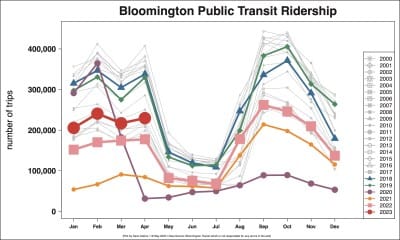Bloomington public bus notebook: Uber-Lyft late night continues, paratransit to get same-day service

Now set to continue, but with a few tweaks, is pilot program started last year by Bloomington Transit (BT), to replace late night service on some routes—with vouchers that can be used on Uber or Lyft.
 The Uber-Lyft option is branded as BT Late Nite.
The Uber-Lyft option is branded as BT Late Nite.
The approach of using transportation network companies (TNCs) as a replacement for running 40-foot buses on fixed routes is known in the public transportation industry as “microtransit.”
The geographic area served by BT Late Nite includes the parts of town served by routes that had their late evening service discontinued last year.
BT general manager John Connell briefed the board on program changes at its regular monthly meeting on Tuesday.
For the pilot program, BT Late Nite passengers paid the same $1 fare that fixed route passengers do. For the continuation of BT Late Nite, Connell said, passengers will pay $2, because BT considers it a “premium” service. That’s because the Uber and Lyft service goes from a passenger’s departure point to their destination, not just from bus stop to bus stop.
Despite doubling the passenger fare, BT will still be subsidizing most of the cost of rides taken on BT Late Nite. In March of this year, BT paid out around $56,000 to the two transportation network companies (TNCs), for the roughly 6,000 trips that were taken.
That works out to an average subsidy of about $9.42 per ride. That’s still in the ballpark of what it was costing BT to provide fixed-route service for the time of day when BT Late Nite operates—from 9 p.m. to midnight.
Fares on fixed-route buses generally, at all times of the day, don’t cover the full cost of providing the service. The difference is made up with local property taxes, state, and federal funding.
For 2019, the most recent full year not impacted by the COVID-19 pandemic, BT’s farebox recovery ratio for its fixed-route buses was about 24 percent, based on information submitted by BT to the National Transit Information Database. That means fares covered 24 percent of the cost of providing the service.
Also at Tuesday’s meeting, Connell told the board that the maximum amount BT would pay per ride for BT Late Nite would drop from $19 to $14.
BT will end a different microtransit program that was piloted, which is called Eastside On-Demand. That service operated during the day, not just during late evening hours. It was meant to provide a replacement service for riders who had used the former Route 8, which was eliminated last year.
Connell told the board on Tuesday, that the money BT has been putting into Eastside On-Demand will be directed towards converting BT’s paratransit service to a same-day service. Currently, BT’s paratransit service, which is branded as BT Access, requires scheduling rides a day in advance.
Also at Tuesday’s meeting, Connell told the board that he is looking to add to BT’s stable of drivers, as he looks towards the possible increased levels of service in the fall. The number of service hours provided by BT right now has still not returned to pre-pandemic levels.
The amount of service BT puts on the street this fall could depend on how negotiations with Indiana University unfold, Connell told the board.
IU pays Bloomington Transit around $1 million a year so that students, faculty and staff can board the bus, just by showing their university ID. Next year’s contract is currently being negotiated with the university. Connell is not sure if IU wants to return to the same level of service for campus routes that BT was providing before the pandemic hit.
Fixed route BT ridership continues to show a better trend than last year. The year-to-date ridership numbers are up by 32 percent over last year.
But the 230,000 rides given in April this year were still just about 70 percent of the 314,000 rides that were given in April 2019.




Comments ()